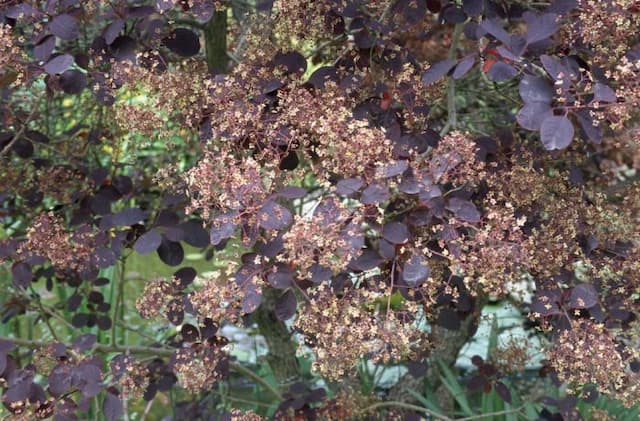Smoke tree Cotinus coggygria











ABOUT
The plant commonly known as Smoke Tree or Smoke Bush is known for its distinctive, ornamental appearance that catches the eye in any landscape. The Smoke Tree features an array of leaves that are rounded and can vary in color from a rich purplish-red to a blue-green, adding a splash of color throughout the seasons. During the fall, the leaves can transform into brilliant hues of orange, red, and gold, creating a striking display. What truly sets the Smoke Tree apart is its ethereal, cloud-like puffs of flowers that bloom in the summer, giving the plant a smoke-like effect. These flowers are airy and come in shades of pink to purple, resembling billowy, soft plumes of smoke. The overall effect is one of a soft, hazy cloud of color that adds a mystical quality to the plant's surroundings. This deciduous shrub or small tree is often praised for its visual interest and can serve as a focal point in the garden due to its eye-catching attributes.
About this plant
 Names
NamesFamily
Anacardiaceae.
Synonyms
Smoke Tree, Smoke Bush, Venetian Sumach, European Smoke Tree, Dwarf Smoke Bush, Royal Purple Smoke Bush, Smoketree.
Common names
Rhus cotinus, Cotinus cotinoides, Cotinus americanus, Rhus cotinoides.
 Toxicity
ToxicityTo humans
The most common name for Cotinus coggygria is Smoke Tree. Smoke Tree is not widely recognized as a toxic plant to humans. There is limited information available regarding its toxicity, and it's not typically considered a plant that causes poisoning upon ingestion. However, like with many plants, some individuals may have an allergic reaction or experience gastrointestinal discomfort if they ingest parts of the plant. Because plants can vary in their chemical makeup and because individual reactions to plant materials can differ, it's advisable to avoid ingesting parts of ornamental plants like the Smoke Tree. Always seek medical advice if you suspect poisoning or if any adverse reactions occur after handling or ingesting plant material.
To pets
The Smoke Tree, known scientifically as Cotinus coggygria, has not been definitively categorized as a toxic plant for pets. There are no well-documented cases of pet poisoning from the ingestion of this plant, and it is not commonly listed among plants that are known to be hazardous to pets. Nonetheless, it is generally recommended to prevent pets from ingesting plants, as they can have individual sensitivities or allergies, and certain plants may cause gastrointestinal upset or other health issues. If a pet ingests Smoke Tree and displays symptoms of distress such as vomiting, diarrhea, or changes in behavior, it is important to consult with a veterinarian.
 Characteristics
CharacteristicsLife cycle
Perennials
Foliage type
Deciduous
Color of leaves
Varies
Flower color
Varies
Height
10-15 feet (3-4.5 meters)
Spread
10-15 feet (3-4.5 meters)
Plant type
Shrub
Hardiness zones
5
Native area
Europe Asia
Benefits
 General Benefits
General Benefits- Ornamental Appeal: Cotinus coggygria, commonly known as Smoke Tree, is valued for its ornamental foliage, which is purplish-red in some varieties, adding dramatic color to landscapes.
- Seasonal Interest: The plant is renowned for its distinctive, smoke-like flower plumes in summer, providing seasonal interest and aesthetic appeal in gardens.
- Drought Tolerance: Once established, Smoke Tree has good drought tolerance, making it suitable for xeriscaping and low-water-use gardens.
- Low Maintenance: It requires minimal upkeep once established, making it a convenient choice for gardeners with limited time.
- Wildlife Support: The flowers of the Smoke Tree are attractive to bees and other pollinators, supporting local ecosystems.
 Medical Properties
Medical Properties- Anti-inflammatory: Compounds in Cotinus coggygria may help reduce inflammation.
- Antioxidant: The plant has been reported to have antioxidant properties that may protect cells from damage.
- Antimicrobial: Extracts from the plant might exhibit antimicrobial effects against certain pathogens.
- Anticancer: Some studies suggest that substances in Cotinus coggygria could exhibit anticancer activities.
- Hepatoprotective: It may offer some degree of liver protection against certain toxins.
 Air-purifying Qualities
Air-purifying QualitiesThis plant is not specifically known for air purifying qualities.
 Other Uses
Other Uses- Cotinus coggygria, commonly known as Smoke Tree, can be used in landscaping as a natural hedge or privacy screen due to its dense foliage.
- The plant is sometimes utilized as a natural dye source, with the leaves and wood producing shades of yellow and orange on fabrics and yarns.
- Wood from the Smoke Tree is appreciated in woodworking for small projects such as crafting decorative items or inlay work due to its distinct color and grain.
- Smoke Tree twigs and branches are sometimes incorporated into floral arrangements and wreaths for their unique shape and color, adding visual interest.
- Due to its drought tolerance and ability to thrive in poor soils, the Smoke Tree is used in reclamation projects to help stabilize soil and prevent erosion.
- The leaves of the Smoke Tree can be used in the garden as mulch, which helps retain soil moisture and suppress weeds.
- Smoke Tree's vibrant fall foliage makes it a perfect candidate for creating bonsai, offering seasonal color and an interesting structure.
- In the art of topiary, the malleable branches of the Smoke Tree can be trained into various shapes and structures to enhance garden design.
- Smoke Tree branches may be used as natural insect repellents when burnt, as the smoke is believed to deter insects.
- The distinct appearance of the Smoke Tree during different seasons makes it an excellent subject for photography or botanical studies, focusing on the morphology of trees.
Interesting Facts
 Feng Shui
Feng ShuiThe Smoke tree is not used in Feng Shui practice.
 Zodiac Sign Compitability
Zodiac Sign CompitabilityThe Smoke tree is not used in astrology practice.
 Plant Symbolism
Plant Symbolism- Regeneration: Cotinus coggygria, commonly known as Smoke Tree, exhibits vigorous regrowth after being cut back, symbolizing the ability to recover and regenerate after hardship.
- Illusion: The wispy, smoke-like flowers of the Smoke Tree can create an illusion of smoke hovering above the foliage, representing things not always being as they appear.
- Mysticism: With its ethereal appearance, the Smoke Tree is often associated with a sense of mystery and the mystical aspects of nature.
- Transformation: The Smoke Tree undergoes a dramatic change in autumn when its leaves turn vibrant colors, symbolizing transformation and the cycle of life.
- Protection: In some cultures, the dense, cloud-like clusters of the Smoke Tree's flowers were believed to offer protection and hide one from negative energies or thoughts.
 Water
WaterThe smoke tree (Cotinus coggygria) needs regular watering to establish its root system, especially within the first growing season. After establishment, it becomes more drought tolerant and requires less frequent watering. Typically, a young smoke tree should be watered deeply once a week, providing about 1-1.5 gallons of water per session. During hot or dry spells, you may need to increase the watering frequency to twice a week. Make sure to water the plant at the base and avoid wetting the foliage to reduce the risk of fungal diseases.
 Light
LightSmoke tree prefers full sun conditions to thrive and produce the best leaf color and blooms. It requires at least six hours of direct sunlight each day. The ideal spot for a smoke tree is in a location that receives unfiltered, full sun throughout most of the day, which will encourage vibrant foliage and strong growth.
 Temperature
TemperatureThe ideal temperature range for a smoke tree is between 50°F and 80°F, though it can tolerate temperatures as low as 20°F in winter and as high as 100°F in summer. It is a hardy plant that can survive in USDA hardiness zones 4 through 8, making it versatile for various climates.
 Pruning
PruningThe smoke tree should be pruned to remove any dead or diseased branches, to shape the plant, and to promote new growth. Prune in late winter or early spring before new growth begins. Depending on your aesthetic preference, you can perform a hard prune to encourage bushier growth or just lightly trim the tree for shape. Prune every year or every few years as needed.
 Cleaning
CleaningNot needed
 Soil
SoilThe Smoke Tree enjoys a well-draining soil mix with a slightly alkaline to neutral pH level (around 6.0 to 7.5). A mixture consisting of loamy soil amended with compost or well-rotted manure will provide the necessary nutrients and drainage. It prefers dry to medium moisture soils and can tolerate some drought once established.
 Repotting
RepottingSmoke Trees are not typically grown in containers and therefore do not require regular repotting. If grown in a pot, repotting every 2 to 3 years or when the plant becomes root-bound can help maintain its health.
 Humidity & Misting
Humidity & MistingSmoke Trees are tolerant of a wide range of humidity levels and do not require specific humidity conditions. They thrive in outdoor environments where the humidity is naturally regulated by the climate.
 Suitable locations
Suitable locationsIndoor
Provide bright light, minimal water, and no extensive care for indoor Smoke Trees.
Outdoor
Plant in full sun, well-drained soil, and ensure ample space for growth.
Hardiness zone
5-8 USDA
 Life cycle
Life cycleThe life cycle of Cotinus coggygria, commonly known as the smoke tree, begins with seed germination, which occurs in Spring after stratification, or a period of cold to break dormancy. The seedlings grow and establish a root system, developing into juvenile plants. As they mature, smoke trees produce distinctive, large, plume-like flowers in the summer, contributing to their common name. After flowering, the plant sets seed which is then dispersed by wind due to their lightweight and aerodynamic structure. The plant reaches full maturity in several years and can live for decades, growing into a multi-stemmed shrub or small tree. Seasonally, it undergoes dormancy in winter, shedding its leaves and entering a period of rest before the cycle begins anew with the next growing season.
 Propogation
PropogationPropogation time
Late Winter to Early Spring
Propogation: The Smoke Tree, commonly known as Cotinus coggygria, is most successfully propagated through the cutting method during summer when the plant is actively growing. Semi-hardwood cuttings, which are stem pieces from the current year's growth that have begun to mature, are typically taken in midsummer. To propagate by cuttings, one should select a healthy, non-flowering stem, cut a section about 4 to 6 inches (10 to 15 centimeters) long, and remove the leaves from the lower half. The cutting should then be dipped in rooting hormone to encourage root growth and planted in a well-draining potting mix. It's important to maintain a high humidity environment for the cuttings, often achieved by covering them with a plastic bag or placing them in a propagator. With proper care, roots usually develop within a few weeks, at which point the new Smoke Tree can eventually be transplanted outdoors.
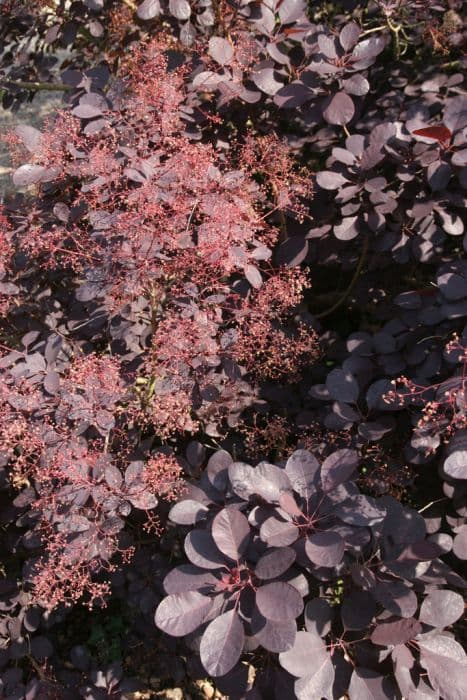
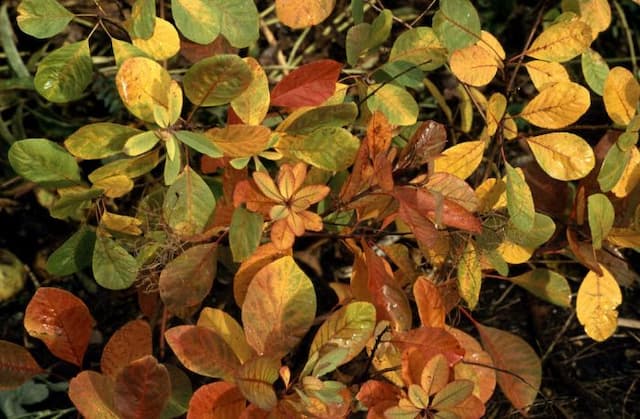

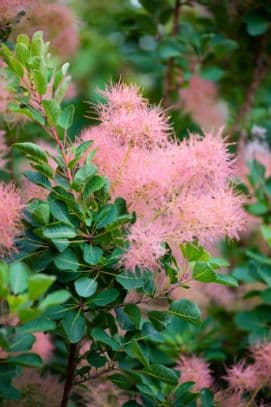
![Smoke tree [Golden Spirit]](/_next/image?url=https%3A%2F%2Fplants-admin.emdemapps.com%2Fimages%2Fplants%2F%2Fimages%2F604b63b450a12.png&w=640&q=75)
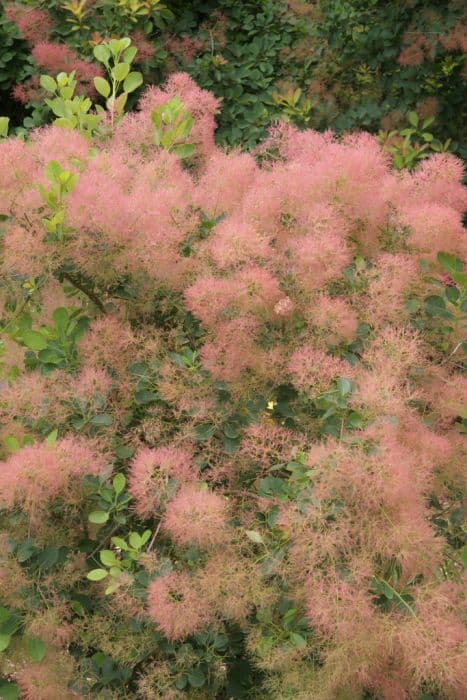

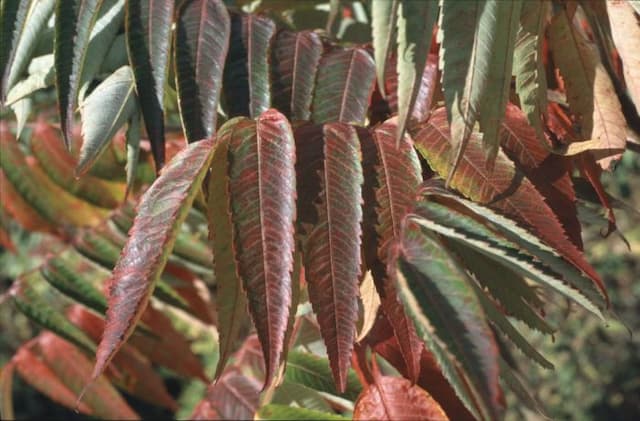
![Stag's horn sumach [Radiance]](/_next/image?url=https%3A%2F%2Fplants-admin.emdemapps.com%2Fimages%2Fplants%2F%2Fimages%2F604b6223f1c1d.png&w=640&q=75)
